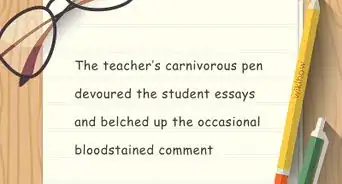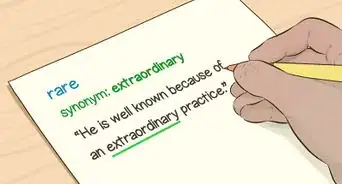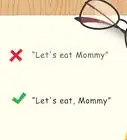This article was co-authored by Megan Morgan, PhD. Megan Morgan is a Graduate Program Academic Advisor in the School of Public & International Affairs at the University of Georgia. She earned her PhD in English from the University of Georgia in 2015.
There are 14 references cited in this article, which can be found at the bottom of the page.
This article has been viewed 54,064 times.
In order to communicate effectively, it is important to be specific, rather than vague or ambiguous. Whether you are speaking or writing, you will have a much easier time getting your point across clearly when you choose descriptive words and have a precise intention in mind. Take some time to plan your message, and you will soon be enjoying the benefits of more specific communication.
Steps
Deciding What Information to Include
-
1Choose a topic that you're knowledgeable about. The more you know about something, the easier it will be to conjure up specific images and facts.
- If you're not knowledgeable about your topic, do some research so you can talk or write about it with more detail. If you are trying to be specific for an assignment, you'll probably need to do research.
- If you're still not feeling confident in your abilities, look for ways that you can connect the topic to something you are more familiar with, or try to think of a sub-topic that you are more comfortable with. For example, if you have been assigned to talk about climate change, you could choose to talk about a particular aspect that you can connect with on a personal level, such as your love of polar bears and the danger that climate change will threaten their habitats.[1]
-
2Decide on a call to action. This may sound complicated, but all it means is narrowing the focus of your argument and clearly stating what action you want people to take -- in other words, the purpose for your writing or speech. Whether you're telling a fictional story or making a philosophical argument, think about how you want people to feel and react. Don't lose sight of this objective as you continue to write or speak.[2]
- "Call to action" is a term typically used in marketing, but it can be used to apply to any kind of speaking or writing. No matter what the topic, think about your essay or speech as a marketing tool meant to convey a specific message and get people to react in a specific way.
- Common purposes include: informing, persuading, recommending, arguing, advocating, explaining, instructing, and defending.
- For example, if you have chosen to write about polar bears and climate change, your call to action might be related to the actions your audience can take to reduce the effects of climate change.
Advertisement -
3Make sure you answer the question. If you are responding to a question, rebutting someone else's argument, or completing an assignment, think carefully about the specifics of the question you need to answer. It's okay to add some additional information on top of what was asked of you, but first you need to make sure your response thoroughly answers the specific question.[3] [4]
- Think about which question word or words were used in the question. For example, if you were asked to describe what you do at work, it can be very easy to get sidetracked by talking about related topics, such as how you perform your job or why you chose your career path. This information might be interesting or important to your audience, but don't forget to answer the question first.
-
4Think about length. If you have to write a certain number of words or speak for a certain amount of time, make sure you are able to fit all of the most important information into your argument. If length is not dictated, think carefully about your message, your topic, and your audience to determine the appropriate length. You should aim to provide all the information your audience needs without challenging their attention spans.[5]
- Consider using the inverted pyramid style, which prioritizes the most essential information, and leaves less important details for the end, if you are concerned about your audience's attention span. This is not appropriate for every style of writing or speaking, but if you need to communicate a few key points, it can be a helpful tool.
- If you have extra time or space that you need to fill, don't just add in extra words that don't provide any additional detail or insight. Instead, look for places where your audience would benefit from more detail, or try thinking of another connection you can make or another example you can cite.
- Provide background information only if it's relevant. Irrelevant details will make your whole argument seem less directed.
-
5Give examples. Whether you are speaking or writing, your purpose will usually be to make an argument, and you will need examples to support that argument in order to make your audience believe it. Evidence is crucial to being specific.[6]
- Examples are explicitly stated in some formats, like political debates and research papers, and can be introduced directly by saying something such as, "For example." In other genres, such as creative writing, examples are more implicit. You may, for example, need to describe what a character is wearing and where she likes to shop for clothing, in order to communicate to your audience that she is fashionable.
- While examples are essential, be careful not to overwhelm your audience. If you provide too many unrelated examples, your audience might lose track of your main point. You can avoid this by carefully evaluating all of the details you plan on using for each example and making sure there is always a direct connection back to your main argument.
-
6Consider all the question words. Unless the topic of your message is very narrow, you will usually want to answer who, what, when, and where. This is especially important in business communications. If you need something from someone, you will need to communicate what you need, who needs to do it, when it needs to be done, and where it needs to be done.[7]
- How and why may or may not be important, depending on your message. Think carefully about how your audience will interpret your message, and never assume that they will know what you mean unless you tell them.
-
7Avoid generalizations. Generalizations often end up in writing when you aren't sure what else to say. Common examples include "Since the beginning of time" or "People think..." These statements are usually too abstract and general to be helpful, and because they make such sweeping statements, they're also likely to be untrue.[8]
- For example, instead of beginning an essay by saying "Modern life has deteriorated because of technology," you might say "According to some experts, technology has caused communication problems between people and increased loneliness."
Choosing Your Words
-
1Use adjectives and adverbs. Descriptive words will help your audience understand exactly what it is you are talking about and make it more interesting for them to continue reading or listening. However, you don't want to go overboard with these, as they may be redundant or lack impact.[9]
- Think about how others might visualize the words you are using. If your words do not create a clear picture in your audience's head, chances are your language is too vague. For example, if you just say, "The man went to his house," your audience will not know what to imagine. If you say, "The tired old man went to his dark, empty house," your reader will be better able to imagine the scene.
- However, the sentence "She stuttered haltingly as she spoke" uses an adverb inappropriately. "Stuttered" already includes the idea of halting speech, so the adverb is redundant -- or "fluff," in creative writing lingo.[10]
- If you're not sure whether or not your language is descriptive enough, read it to some of your peers and ask them to judge you on how you've done. Ask them where you were lacking in detail or where your language was not clear.
- Instead of describing every single object you mention, focus on the ones that are most important to your message.
-
2Use proper nouns. Leave no room for confusion in your message by referencing names, titles, and places whenever possible.[11]
-
3Use time-sensitive words. Make sure your audience understands exactly when something needs to be done by using specific terms like "on Monday" or "before 4:30 EST" instead of more vague terms like "next week" or "soon."[12]
-
4Show, don't tell. For creative writing, use descriptive words and phrases based on all five senses: sight, smell, taste, hearing, and touch. This can also be useful for other types of writing and speaking because it will allow your audience to experience the situation themselves and draw their own conclusions.[13]
- For example, the sentence "Deshawn was very happy" is not very detailed. It does not give the reader any idea of what Deshawn's happiness feels like. Instead, try something like "Deshawn felt his heart hammer in his chest as he rushed down the street to find his friend. He couldn't wait to share his good news." This concrete, specific detail about how Deshawn feels allows the reader to understand those emotions better.
- In order to describe things in detail, you need to learn to observe them in detail. If this is difficult for you, practice paying attention to the tiny details involved in an everyday task, keeping all five senses in mind.
-
5Know when to paraphrase. If you are referencing someone else, consider using an exact quote. This works best when the quote is clear and succinct. If your source is difficult to understand or unnecessarily complicated, consider paraphrasing in order to better communicate the specific relevancy to the point you are trying to make.[14]
- Dialogue is essential to plot development and characterization in creative writing, so write it out instead of paraphrasing the conversation.[15]
-
6Expand your vocabulary. A broad vocabulary will help you communicate better because it will give you access to more words, allowing you to choose the one that conveys the exact details you were looking for.
- Complex words are the right choice for some situations, but you should avoid using language that your audience will not understand. Remember, the main point is to effectively communicate your message, not to flaunt your vocabulary. You should also be cautious about using technical jargon if your audience is not likely to be familiar with it.
- Dictionaries and thesauruses are very helpful tools if you are looking for the right word to describe something. If you are not sure if you are using a word correctly, always use a dictionary to check.
-
7Avoid over-complicated syntax. Make sure to place words in the correct order and use proper sentence structure so that your words will flow together. This will make things seem more clear and concise.[16] For example, compare the following sentences:
- "Industrial spying, because of the growing use of computers to store and process corporate information, is increasing rapidly." This is not clear, because the subordinate clause interrupts the main idea.
- "Industrial spying is increasing rapidly because of the growing use of computers to store and process corporate information." This is clear, because the main idea is presented first.
References
- ↑ http://www.nasa.gov/audience/foreducators/making-earth-science-approach.html
- ↑ https://owl.english.purdue.edu/owl/resource/625/06/
- ↑ http://writingcenter.unc.edu/handouts/understanding-assignments/
- ↑ http://writingcenter.unc.edu/handouts/argument/
- ↑ https://owl.english.purdue.edu/owl/resource/735/04/
- ↑ http://writingcenter.unc.edu/handouts/evidence/
- ↑ http://menwithpens.ca/how-to-be-specific/
- ↑ http://www.luc.edu/literacy/style_sheets.shtml#generalizations
- ↑ http://www.writersdigest.com/writing-articles/by-writing-goal/write-first-chapter-get-started/nobles-writing-blunders-excerpt
- ↑ http://www.writersdigest.com/writing-articles/by-writing-goal/write-first-chapter-get-started/nobles-writing-blunders-excerpt
- ↑ http://academy.justjobs.com/be-precise-be-specific-and-be-clear/
- ↑ http://www.smallbiztriage.com/how-to-be-specific-in-writing-your-email/
- ↑ http://thewritepractice.com/become-a-better-writer/
- ↑ https://owl.english.purdue.edu/owl/resource/619/1/
- ↑ http://thewritepractice.com/become-a-better-writer/
- ↑ https://owl.english.purdue.edu/owl/resource/600/01/










































































